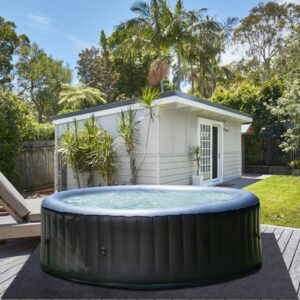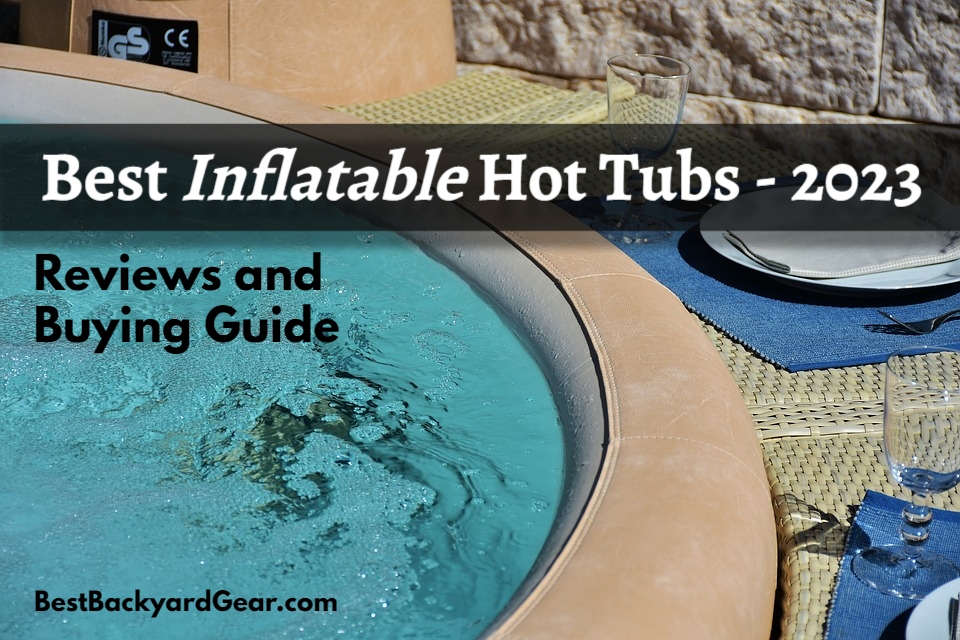 If you’re looking to add an inflatable hot tub to your backyard any time soon, and are planning on setting it up yourself, no doubt you have a few questions. The 2 we’re looking at here today are:
If you’re looking to add an inflatable hot tub to your backyard any time soon, and are planning on setting it up yourself, no doubt you have a few questions. The 2 we’re looking at here today are:
- What is the best base for an inflatable hot tub?
- What should you put between the ground and your inflatable hot tub?
Thankfully, it does not have to be all that complicated or expensive to get a great set up, one that will protect your hot tub investment and have a part in making years of enjoyment.
Let’s take a look.
What Is The Best Base For An Inflatable Hot Tub?
Another way of asking this question might be, “where is the best place to set up an inflatable hot tub?” Or, “what type of ground is best for a hot tub?”
Well, the two most important things to remember when it comes to selecting and preparing your hot tub location are:
- Water is HEAVY. An average sized inflatable hot tub weights approximately 2,200lbs when filled.
- Your tub MUST be set up on a perfectly level surface or you are inviting disaster and an early end to your hot tubbing experiences.
So, deciding where your inflatable hot tub will go isn’t something you do with little thought.

DECK: Many people like to put their hot tub on a patio deck. If you choose to go this route, do your homework to make sure that the deck is reinforced properly to be able to handle the weight of over 2,000lbs in one small area. Check with a local engineer or deck consultant if you aren’t completely sure.
GROUND: If you are thinking to put your inflatable spa directly on the ground, you should have a proper base built for it, similar to what you’d do if you were putting in an above ground pool. Level it out perfectly. Put in a thick, even layer peat moss, crushed stone, or pea gravel before laying down a good quality hot tub mat over that.
GRASS: If you are planning to put your inflatable hot tub simply and directly on the grass of your lawn, well… don’t. Soil will sink under the weight of the tub, and rough items (roots, stones) in the soil that you didn’t see will show up, putting direct stress on the base of the tub. Your tub liner will also be exposed to wet soil and grass – this exterior moisture will damage the liner fairly quickly.
CONCRETE: The best choice is to put your inflatable hot tub on a base of concrete. Yes, you will definitely want to make sure you have a mat or pads between the concrete and the tub liner to reduce friction. But concrete is the best base for an inflatable hot tub as it can handle the weight easily, is generally very level, and it keeps everything nice and clean.
Whatever you choose, remember, you’ll need to be setting up close by an electrical outlet, so that you can connect your pool equipment to a power source.
Haven’t picked out an inflatable hot tub just yet? Check out these reviews of the Best Inflatable Hot Tubs of 2023 for some inspiration!
What To Put Between The Ground And Your Inflatable Hot Tub

Your sole intent with putting something between your inflatable hot tub and the ground surface is to protect the bottom of your hot tub from any roots, stones, sharp grasses, glass fragments in the dirt, rough concrete patches, or straw that is underneath it. Even these small objects will slowly cause your tub’s exterior stress due to constant pressure of the heavy water (and people walking on it), and they may eventually pierce through the skin of the pool.
Yes, inflatable hot tubs are designed to be able to handle a fair bit these days, as far as the material goes (and many pics of on the sales pages for inflatable hot tubs show tubs sitting smack against the grass or concrete), but it should be obvious that they are not impenetrable.
You want a go-between. It doesn’t have to be complex or expensive, but you do want SOMETHING that will protect your investment.
Simplest Inflatable Pool Base Option: A Felt Liner Pad
Your simplest to install and likely most inexpensive option is a felt liner pad.
These are also known as pool protector mats, ground cloth, hot tub mats for inflatable pools, hot tub flooring protector mats, or hot tub mat pads.
Depending on the thickness and quality that you choose, you can pick one up for under $60. Some of the higher end, thicker hot tub mat pads will run nearer to $120. But overall, these are simple to lay, effective, inexpensive bases for inflatable hot tubs.
Pros:
- A inflatable hot tub mat made from felt quickly soaks in any splashes and drips, so you don’t need to wipe around the hot-tub after using it, nor is it slippery!
- Felt hot tub mat pads can usually be washed easily.
- You can very easily cut them to the exact size and shape of your tub if you don’t want it visible
Con:
- Felt mat pads are generally quite thin and as such do not have much use when it comes to conserving heat (protecting against the cold ground).
A Step Up: Interlocking Foam Tiles or Pads
The next option, and what may be considered slight better and nicer than a roll of felt, would be interlocking foam pads. You can get them in various thicknesses (1/4″, 1/2″, etc.), and overall, they are not a whole lot more expensive than the roll of felt pool liner pad.
You can also purchase them pre-shaped to the exact size of your inflatable hot tub, or select a variety that is a square or rectangle to allow for some standing space when you aren’t in the tub.
Pro:
- Foam creates a slightly softer option for the inflatable hot tub to rest on. It is more shock absorbent, and nicer for standing on in the tub than direct hard ground.
- If you have decided to set up your inflatable hot tub on grass, foam tiles like these do a great job evening out slight variations and bumps in the soil.
- Foam tiles are somewhat more insulating than felt against the cold of the earth.
Con:
- Foam pads can be rather slippery when wet, especially if there is no texture on them. (Selecting the exact size of your tub, or trimming the foam to shape is wise advice that’ll handle this negative point.)
Best Inflatable Pool Base Option: Thick, Plastic Resin Base Pads.
Heavy duty interlocking resin pads give you a safe, smooth, durable, protective base for your inflatable hot tub. You can’t do much better than these, and you may want to consider buying them if money is not a problem and you need to set up your hot tub on a rough or unprepared surface.
They are made from polyethylene resin, which is washable, and extremely resistant to mold and rot. They have a very long lifespan due to their high quality – honestly, they will likely outlast your hot tub.
These pads interlock and are easy to reposition if you need to. Pictured is 3, so you’ll need 2 packs to get to a nice square for your tub to stand on. You can not cut these into a round shape.
Pro:
- These expensive pads have significantly better heat retention than thin foam or felt pads. This better energy efficiency will save you money as you won’t have to run the water heater as much when the ground is frozen.
- They are cheaper than having a concrete pad poured, but are significantly thick and sturdy enough to do the job pretty much as well as concrete.
Con:
- These are NOT cheap. You may find it not worth it when you consider that the price of these resin pads probably going to cost you more than the inflatable hot tub itself. However, if you are trying out an inflatable tub with the intention to move to a solid hot tub at some point, these resin pads will be reusable under a heavy solid one as well.
If you are here to learn about hot tub base liners because you happened to have a hole in your tub due to NOT putting a base liner in, take a look at “How To Patch An Inflatable Pool” for a quick sec. Maybe it’ll rescue your current hot tub!
Hopefully these answers to what is the best base for an inflatable hot tub have been helpful! If there is something I haven’t addressed, please let me know in the comments below, and I’ll do my best to help you out.
Wishing you much enjoyment of your inflatable hot tub this season!








